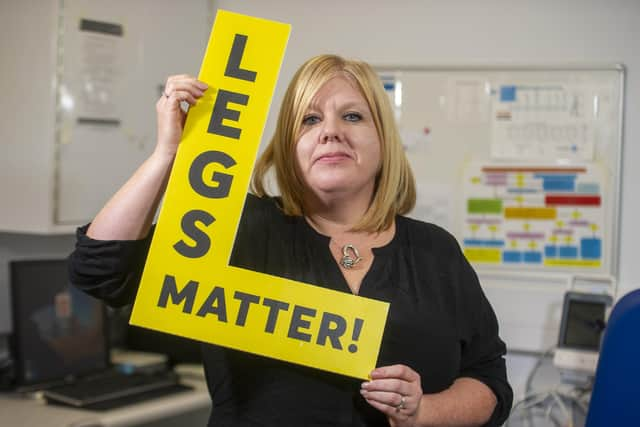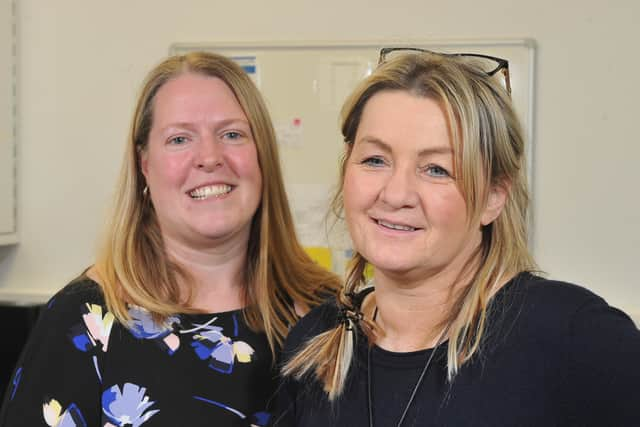‘Both my legs were amputated - but I still walked down the aisle six weeks later’
and live on Freeview channel 276
When Kara Keal developed a blister on her foot after a night out with friends in Blackpool, she could not have imagined that within two years she would have lost both of her legs below the knee to emergency amputations. Incredibly, she defied this nightmare scenario to walk down the aisle at her wedding with her prosthetic limbs just six weeks after the second amputation.
Keal is determined to do everything she can to prevent others suffering a similarly traumatic experience to what she went through around 15 years ago and now the 50-year-old from Ossett is supporting the recently launched Legs Matter campaign, which is both demanding improved care standards for leg wounds from the NHS and giving patients information on how their conditions should be treated, as well advice on ways to prevent problems from occurring in the first place.
Advertisement
Hide AdAdvertisement
Hide Ad“If I can help other people from my experience then it has been a positive,” says Keal.


Keal’s problems began when she was 34. Having been diagnosed as a Type 1 diabetic when she was seven, she lived a normal life with the help of antibiotics. But after getting a blister on her left foot from the shoes she was wearing on her weekend away with friends in Blackpool, she developed a diabetic foot infection and she ended up in hospital. Doctors initially removed her big toe and then part of her foot in an attempt to prevent the infection spreading. But with the wound becoming septic and putting her life at risk, more dramatic surgery was required.
“The surgeons said the only thing we can do is take your leg off below the knee,” she recalls. “I was quite distressed but it was a bit matter of fact, there was no other way. I woke up the next morning and I have never felt as well in my life. I had got a full face of make-up on by the time my son arrived to see me in hospital. Six weeks later, I walked to school to pick him up with my prosthetic leg. His face was a picture when he saw me.”
But as she was adjusting to a new way of life, less than two years later Keal developed another diabetic foot infection from a blister on her right foot she got after burning it on a radiator. And in contrast with what happened on the first occasion, Keal says the care she received for the wound which developed was deeply flawed.
Advertisement
Hide AdAdvertisement
Hide Ad“I had district nurses and I will never have one in my house again. I think I could have done what they needed to do better than they did,” she says.


Keal says having been through her first experience, she more easily picked up on instances of poor practice, such as one nurse who answered the phone while doing her dressing and then went back immediately to treating the wound without taking any steps to prevent cross-infection.
Keal says that soon afterwards it was suggested by district nurses that her wound was healing, but when it was checked in hospital by a specialist the wound was black and her right leg was amputated below the knee the next day. “I was quite upset when I knew had to have my leg off. But I thought ‘crack on’. I was getting married six weeks later and I did manage to walk down the aisle. I have always lived life to the full. When I lost my first leg, I had just split up with my first husband and I was on my own. My son was seven and he was actually my carer at one point. When I look back, I feel for him rather than myself but what has happened has happened.”
Another supporter of the Legs Matter initiative is 40-year-old Tracy Goodwin from Wakefield, who has had to deal with decades of problems linked to a leg ulcer. At one point, the mum-of-two was finding it so painful and debilitating she asked doctors to amputate her leg but they instead performed a deep vein transplant to ease the pain.
Advertisement
Hide AdAdvertisement
Hide AdGoodwin developed deep vein thrombosis when she was 20 and pregnant with her first child and it occurred again when he was born. “It damaged my veins and I didn’t realise the impact at the time,” she says.
“When he was about three years old, I knocked my left leg. It went into a little blood blister and either the next day or the day after when I was looking after my son and my neighbour’s son it just started bleeding like a fountain.”
Initially, the wound was not treated as an ulcer and it was not until she saw wound specialist Dr Leanne Atkin, one of the driving forces behind the Legs Matter campaign, that it was identified as such and properly treated. “Leanne was the first one to say this is a leg ulcer. It healed within about 12 weeks. At the time that seemed a ridiculous amount of time but looking back it wasn’t at all.”
The problem reoccurred three years later in 2005 when Goodwin banged her leg on a flight back home from holiday. “From that point onwards it took the best part of 14 years to heal. We tried everything – it got smaller, it got bigger. I had two small children and I was in so much pain that for about 18 months I couldn’t even get up the stairs. I used to sleep downstairs so I could put on the telly to distract myself from the pain.”
Advertisement
Hide AdAdvertisement
Hide AdGoodwin’s ulcer was finally healed earlier this year with a new form of treatment and she says she has been incredibly fortunate to have been supported throughout her battle by Atkin and specialists at Pinderfields Hospital. However she says she has also experienced poor levels of care, including from a pharmacist she initially saw who failed to advise her to visit a GP as well as from a practice nurse who improperly applied compression bandaging and left her leg with “the biggest dents you have ever seen”.
Atkin, who is chair of Legs Matter as well as being a vascular nurse consultant for the Mid Yorkshire NHS Trust and a lecturer at Huddersfield University, says stories of inadequate care such as those experienced by Keal and Goodwin are prevalent. “One of the major problems is that patients can’t recognise bad or good care. They might have had a wound for 12 months and that poor patient is sending their nurse a Christmas card because they think they are friendly. But really the care has been rubbish. Legs Matter can empower patients to know what is right and what is wrong in terms of their treatment.”
Atkin says it is reported up to 80 per cent of major limb amputations are preventable, while major amputation rates are 30 per cent higher in the North compared to the South. She says this figure is thought to be down to higher levels of obesity and diabetes in the North, as well as variations in the commissioning of NHS services.
She says current statistics that fewer than half of patients with leg ulcers currently heal within 12 months and wound care costs the NHS £5.3bn per year can be dramatically improved with some simple steps. “We need a whole system change to get these patients to heal. The hope is to change the status quo.”
Advertisement
Hide AdAdvertisement
Hide AdLeanne Atkin says many patients are reluctant to seek help for leg wounds and ulcers.
“There is a great stigma because we call it ulceration – patients are fearful of that,” she explains. “It can be something that generates shame and a sense of a loss of control over your body.
“It is something people can be embarrassed about and not want to seek help for. What we are trying to do is break down people’s worries and say we are used to this and it is not your fault.”
Among those supporting the Legs Matter campaign are leading clinicians and eight healthcare charities such as The Tissue Viability Society and The College of Podiatry.
For more information about the initiative, visit www.legsmatter.org.